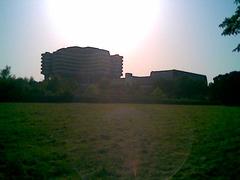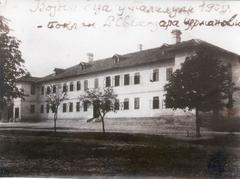Military Medical Academy Belgrade: Visiting Hours, Tickets, and History Guide
Date: 14/06/2025
Introduction
The Military Medical Academy (MMA) in Belgrade, Serbia, stands as a unique institution at the intersection of military history, medical excellence, and architectural achievement. Founded in 1844 as Serbia’s first military hospital, the MMA has evolved over nearly two centuries into one of the most significant centers for healthcare, education, and research in the Balkans. Its legacy encompasses roles in wartime medical care, pioneering research, and contemporary public health, all set within an iconic brutalist architectural complex on Banjica Hill.
This guide offers a comprehensive overview of the MMA’s history, architecture, and practical visitor information, including visiting hours, accessibility, and nearby attractions. Whether you are a history enthusiast, architecture aficionado, or a visitor seeking insights into Serbian culture and medicine, this article provides essential details for a meaningful visit.
For further details, consult the Official Military Medical Academy Website, The Crazy Tourist’s Best Things to Do in Belgrade, and Minimal Belgrade’s Architectural Portfolio.
Table of Contents
- History and Institutional Evolution
- Architectural and Cultural Significance
- Role in Public Health and Research
- Visitor Information
- Frequently Asked Questions (FAQ)
- Visuals and Media Suggestions
- Sources and Further Reading
- Conclusion
History and Institutional Evolution
Founding and Early Years
The MMA was established in 1844, during a period of Serbian modernization under Prince Aleksandar Karađorđević. Initially serving as a military hospital for the growing Serbian army, it laid the groundwork for organized military medicine in the region. By 1889, it had become an official academy under the Ministry of War, reflecting Serbia’s aspirations to align with European military-medical standards.
Through Conflict and Change
The MMA’s role was pivotal during the Balkan Wars, both World Wars, and the Yugoslav conflicts of the 1990s. It provided essential emergency care, managed epidemics, and innovated under crisis conditions. After WWII, the institution became part of the Yugoslav People’s Army medical system, broadening its mission to include both military and civilian care and expanding its research and educational functions.
Modern Growth and Recognition
In 1978, the MMA moved to its current Banjica location. Its new complex, opened officially in 1982, remains among the largest medical facilities in Southeast Europe. Today, the MMA is Serbia’s leading tertiary care center and a hub for medical education, treating over 400,000 outpatients and performing 25,000 surgeries annually. It is affiliated with the University of Defence and internationally recognized for its expertise in trauma care, surgery, oncology, and infectious diseases (Official MMA Website; EU za tebe).
Architectural and Cultural Significance
Design and Construction
The MMA’s current building is a hallmark of late Yugoslav brutalist architecture, designed by Colonel Josip Osojnik and Slobodan Nikolić. Completed in 1981, the 14-story structure covers 180,000 square meters, with over 6,000 rooms and state-of-the-art medical, research, and teaching facilities. The design emphasizes functionality, modularity, and efficient movement, reflecting both military discipline and medical necessity (Minimal Belgrade; The Amazing Traveler).
Symbolism and Urban Presence
Located on Banjica Hill, the MMA is a visible landmark in Belgrade, symbolizing postwar modernization and the integration of public institutions into urban life. Its fortress-like appearance and geometric forms serve as a metaphor for resilience and progress. The complex also features memorial spaces and a chapel, highlighting its ceremonial and cultural roles.
Ongoing Modernization
The MMA is undergoing major energy and infrastructure upgrades, including new insulation, windows, and heating systems—funded by the EU and Germany’s KfW Bank—to improve efficiency and sustainability while maintaining uninterrupted healthcare services (EU za tebe).
Role in Public Health and Research
Academic Excellence
The MMA houses the Medical Faculty of the University of Defence, training military doctors with a focus on trauma care, disaster response, and preventive medicine. It is a leading research institution and regularly hosts international conferences and health campaigns.
Public Service and International Partnerships
The MMA is renowned for its humanitarian missions and participation in disaster relief, both in Serbia and abroad. Its staff contribute to global research and public health initiatives, collaborating with institutions worldwide (Ministry of Defence Serbia; Euromelanoma Campaign).
Visitor Information
Visiting Hours
The MMA is primarily a working hospital. Visiting hours for patients typically run Monday to Friday, 9:00 AM to 4:00 PM, but can change due to health protocols. Public access to museum or memorial areas and special events is announced in advance. For the latest schedules, check the official MMA website.
Tickets and Entry
There are no entry fees or tickets required for general visits to the hospital or its museum areas. Special tours or events may require prior reservation or registration.
Accessibility
The complex is fully accessible, with ramps, elevators, and facilities for visitors with disabilities. For specific assistance, contact the MMA in advance.
Getting There
- Address: 17 Crnotravska Street, Banjica, Belgrade.
- Transport: Multiple bus and trolleybus lines connect the MMA to central Belgrade; taxis are available; limited on-site parking.
- Navigation: Bilingual signage and information desks assist visitors.
Etiquette and Practical Tips
- Dress: Modest, respectful attire is expected.
- Photography: Generally prohibited inside; ask for permission for exterior or event photography.
- Language: Serbian is official, but many staff speak English.
- Documentation: Bring ID for entry; arrive early for security checks.
- Health: Follow posted hygiene and safety protocols.
Nearby Attractions
The MMA is close to several points of interest:
- Museum of Yugoslavia
- Topčider Park
- Dedinje district
- Green spaces and residential architecture of Banjica See Mapcarta - Banjica District and Belgrade Tourism Official Site for more.
Frequently Asked Questions (FAQ)
Q: What are the Military Medical Academy Belgrade visiting hours?
A: Monday to Friday, typically 9:00 AM to 4:00 PM for patient visits. Public events and museum access may have separate hours; confirm via the official website.
Q: Are tickets or entry fees required?
A: No, there are no general entry fees. Special events may require registration.
Q: Is the MMA accessible for people with disabilities?
A: Yes, the facility is equipped for full accessibility.
Q: Can I take photographs?
A: Interior photography is generally prohibited; seek permission for exterior or public event photos.
Q: How do I get there?
A: The MMA is accessible via public transportation and taxi. See the official website for details.
Q: Can foreign visitors receive treatment?
A: Yes, but foreign visitors should have private insurance or be prepared to pay out-of-pocket.
Visuals and Media Suggestions
- Optimized images of the MMA’s exterior, interior corridors, and public spaces.
- Alt text examples: “Military Medical Academy Belgrade brutalist exterior,” “VMA visitor waiting area.”
- Maps of Banjica district and public transport routes.
- Embedded virtual tour or video, if available.
Sources and Further Reading
- The Crazy Tourist – Best Things in Belgrade
- Minimal Belgrade – Architectural Portfolio
- The Amazing Traveler – Brutalist Architecture in Belgrade
- EU za tebe – Medical Military Academy Reconstruction
- Official Military Medical Academy Website
- Ministry of Defence Serbia – MMA Overview
- Belgrade Tourism Official Site
- Mapcarta – Banjica District
Conclusion
The Military Medical Academy in Belgrade is more than a hospital—it’s a living symbol of Serbia’s resilience, scientific progress, and cultural identity. Visitors can explore its rich history, admire its architectural grandeur, and witness the ongoing evolution of military and public health in Serbia. For the most current information on visiting hours, events, and tours, consult the official MMA website. Enhance your visit by exploring nearby attractions and using resources like the Belgrade Tourism Official Site.
Plan ahead, respect institutional protocols, and enjoy a rewarding experience at one of the Balkans’ most iconic institutions. For travel tips, updates, and local insights, download the Audiala app and explore our related articles.











































































